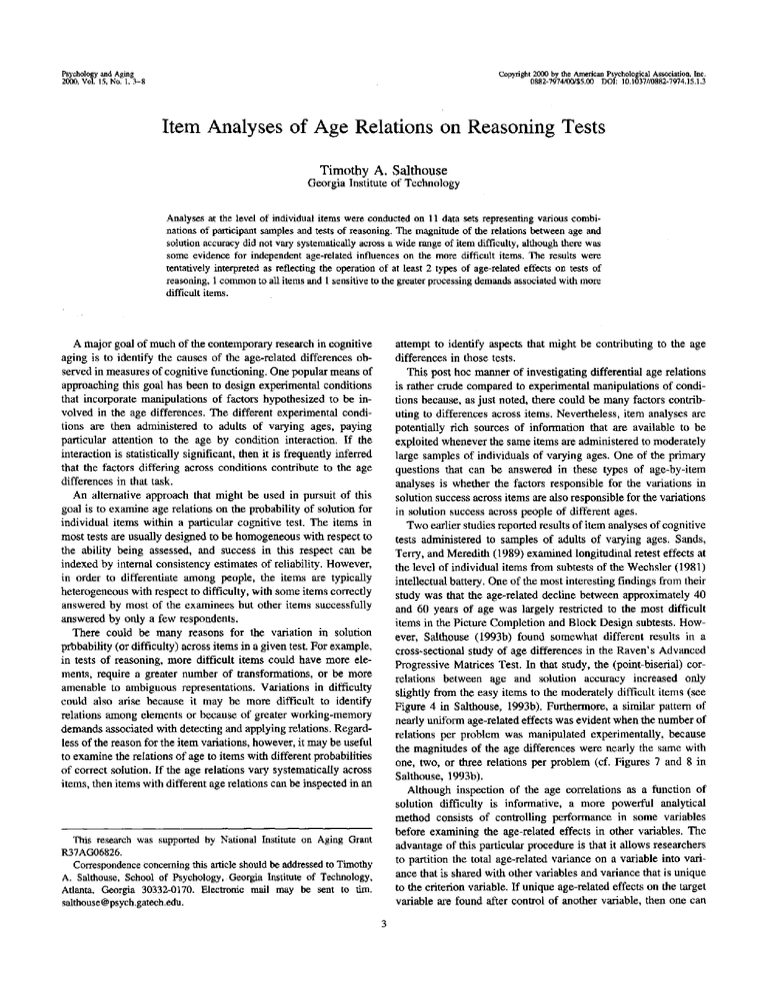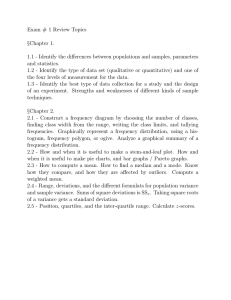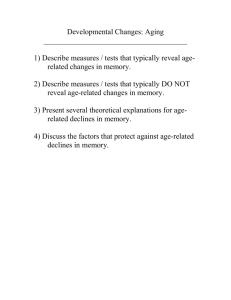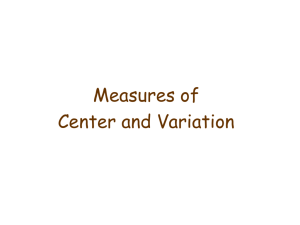Psychology and Aging
advertisement

Psychology and Aging 2000, Vol. 15, No. 1, 3-8 Copyright 2000 by the American Psychological Association, Inc. 0882-7974/00/$5.00 DOI: 10.1037//0882-7974.15.1.3 Item Analyses of Age Relations on Reasoning Tests Timothy A. Salthouse Georgia Institute of Technology Analyses at the level of individual items were conducted on 11 data sets representing various combinations of participant samples and tests of reasoning. The magnitude of the relations between age and solution accuracy did not vary systematically across a wide range of item difficulty, although there was some evidence for independent age-related influences on the more difficult items. The results were tentatively interpreted as reflecting the operation of at least 2 types of age-related effects on tests of reasoning, 1 common to all items and 1 sensitive to the greater processing demands associated with more difficult items. A major goal of much of the contemporary research in cognitive aging is to identify the causes of the age-related differences observed in measures of cognitive functioning. One popular means of approaching this goal has been to design experimental conditions that incorporate manipulations of factors hypothesized to be involved in the age differences. The different experimental conditions are then administered to adults of varying ages, paying particular attention to the age by condition interaction. If the interaction is statistically significant, then it is frequently inferred that the factors differing across conditions contribute to the age differences in that task. An alternative approach that might be used in pursuit of this goal is to examine age relations on the probability of solution for individual items within a particular cognitive test. The items in most tests are usually designed to be homogeneous with respect to the ability being assessed, and success in this respect can be indexed by internal consistency estimates of reliability. However, in order to differentiate among people, the items are typically heterogeneous with respect to difficulty, with some items correctly answered by most of the examinees but other items successfully answered by only a few respondents. There could be many reasons for the variation in solution prbbability (or difficulty) across items in a given test. For example, in tests of reasoning, more difficult items could have more elements, require a greater number of transformations, or be more amenable to ambiguous representations. Variations in difficulty could also arise because it may be more difficult to identify relations among elements or because of greater working-memory demands associated with detecting and applying relations. Regardless of the reason for the item variations, however, it may be useful to examine the relations of age to items with different probabilities of correct solution. If the age relations vary systematically across items, then items with different age relations can be inspected in an This research was supported by National Institute on Aging Grant R37AG06826. Correspondence concerning this article should be addressed to Timothy A. Salthouse, School of Psychology, Georgia Institute of Technology, Atlanta, Georgia 30332-0170. Electronic mail may be sent to tim. salthouse @psych.gatech.edu. attempt to identify aspects that might be contributing to the age differences in those tests. This post hoc manner of investigating differential age relations is rather crude compared to experimental manipulations of conditions because, as just noted, there could be many factors contributing to differences across items. Nevertheless, item analyses are potentially rich sources of information that are available to be exploited whenever the same items are administered to moderately large samples of individuals of varying ages. One of the primary questions that can be answered in these types of age-by-item analyses is whether the factors responsible for the variations in solution success across items are also responsible for the variations in solution success across people of different ages. Two earlier studies reported results of item analyses of cognitive tests administered to samples of adults of varying ages. Sands, Terry, and Meredith (1989) examined longitudinal retest effects at the level of individual items from subtests of the Wechsler (1981) intellectual battery. One of the most interesting findings from their study was that the age-related decline between approximately 40 and 60 years of age was largely restricted to the most difficult items in the Picture Completion and Block Design subtests. However, Salthouse (1993b) found somewhat different results in a cross-sectional study of age differences in the Raven's Advanced Progressive Matrices Test. In that study, the (point-biserial) correlations between age and solution accuracy increased only slightly from the easy items to the moderately difficult items (see Figure 4 in Salthouse, 1993b). Furthermore, a similar pattern of nearly uniform age-related effects was evident when the number of relations per problem was manipulated experimentally, because the magnitudes of the age differences were nearly the same with one, two, or three relations per problem (cf. Figures 7 and 8 in Salthouse, 1993b). Although inspection of the age correlations as a function of solution difficulty is informative, a more powerful analytical method consists of controlling performance in some variables before examining the age-related effects in other variables. The advantage of this particular procedure is that it allows researchers to partition the total age-related variance on a variable into variance that is shared with other variables and variance that is unique to the criterion variable. If unique age-related effects on the target variable are found after control of another variable, then one can SALTHOUSE infer the presence of specific age-related influences that are operating on processes involved in the second variable but not on the first variable. A variety of statistical control techniques can be used for this purpose, but one of the simplest techniques involves the use of two sets of multiple regression e q u a t i o n s - - o n e in which age is the only predictor and a second in which the controlled variable is entered into the equation before age. The residual age-related variance evident in the second equation represents influences that are unique to the target variable because the shared influences are presumably partialled out by control of the other variable. Previous studies have applied this analytical method to ordered sequences of variables based on successive levels of practice, different values of retention intervals, and levels of complexity defined in terms of the number of required operations (e.g., Salthouse, 1996a, 1996b). In nearly all of these cases, large proportions of the age-related effects on ~,ariables late in the sequence appeared to be mediated through effects on earlier variables. Salthouse (1993a, 1998) also applied these same types of independence analyses to successive percentiles in distributions of reaction times in two independent sets of analyses. The major finding in both sets of analyses was that most of the unique age-related effects were evident in the fastest percentiles of an individual's distribution of reaction times. In other words, there were little or no independent age-related effects on the slower percentiles of the reaction time distribution after control of the fastest percentiles. These results led to the speculation that most of the age-related differences in reaction time were likely attributable to influences that operated in a similar fashion throughout the entire reaction time distribution. A similar type of independence analysis can be applied to sets of test items that are ranked in terms of solution probability by controlling the variation in easier items when examining the agerelated effects on more difficult items. The rationale is that if there is significant variance associated with age on the more difficult items after control of the variance in the easier items, then the difficult items can be inferred to have unique age-related influences that are not shared with the age-related effects on easier items. The present article describes the results of reanalyses of data at the individual item level from inductive and deductive reasoning tests administered to samples of between 195 and 390 adults ranging from 18 to over 80 years of age. Nearly all of the participants in the samples reported themselves to be in good to excellent health, and they averaged one to two years of education beyond high school. Further details about the samples and the other tests administered in the studies appear in the articles describing the original studies. Method A total of 11 combinations of samples and tests were included in the analyses. They are described below according to the type of reasoning test that was administered. One data set (Salthouse, 1991, 1993b) included data from 221 adults who performed the Raven's Advanced Progressive Matrices Test (Raven, 1962) with a 20-rain time limit. This is a 36-item test in which the items consist of geometric patterns in eight of nine cells in a 3 × 3 matrix, with the respondent attempting to identify the best completion of the missing cell from a set of eight alternatives. Another data set (Salthouse, Toth, et al., 2000) involved 207 adults who attempted to solve the first 16 odd- numbered items from the Raven's Advanced Progressive Matrices Test. Only 10 min were allowed for the participants to work on this shorter version of the test. Two data sets contained data from locally developed matrix reasoning problems designed to be analogous to the Raven's Progressive Matrices Test. One sample of 390 adults (Salthouse, Hambrick, & McGuthry, 1998) worked on 20 problems with a 10-min time limit, and another sample of 246 adults (S~lthouse, 1994) worked on 36 problems presented in a self-paced format on a computer. It is important to note (see Discussion) that the research participants were allowed as much time as desired to work on the problems in the computer-administered version and all participants attempted every problem. Two data sets involved a slightly modified version of the Cattell Matrices Test (Institute for Personality and Ability Testing, 1973). This test is similar to the Raven's Progressive Matrices Test in that the problems consist of matrices with geometric patterns, but in some problems more than one cell is incomplete. The version administered in these studies consisted of the first 11 items, with a 5-rain time limit. One sample consisted of 202 adults (Hambrick, Salthouse, & Meinz, 1999, Study 1), and the other sample consisted of 218 adults (Hambrick et al., 1999, Study 2). Three data sets contained data from the Shipley Abstraction Test (Zachary, 1986). This is a series-completion test in which the problems have a variety of content (e.g., numbers, letters, and words). A time limit of 5 min is allowed for examinees to work on the 20 problems. One data set consisted of 221 adults (Salthouse, 1991), a second of 202 adults (Hambrick et al., 1999, Study 1), and a third of 218 adults (Hambrick et al., 1999, Study 2). Finally, slightly different versions of an analytical reasoning test based on the Graduate Record Examination (Educational Testing Service, 1994) were administered to two samples. This is a complex deductive reasoning test in which context, constraint, and question information has to be integrated in order to produce a correct answer. One sample of 195 adults (Hambrick et al., 1999, Study 3) worked on 20 items with a 20-rain time limit, and another sample of 200 adults (Hambrick et al., 1999, Study 4) worked on a total of 24 items, with 10 rain allowed for each one of two 12-item sets. Results and Discussion The analyses were designed to attempt to decompose the age correlations on sets of items ordered by solution difficulty into age-related influences that were unique and age-related influences that were shared with easier items. The procedure involved two major steps. First, I divided the items within each test into quartiles on the basis of solution proportions. This resulted in 9 items per quartile in the standard Raven's Progressive Matrices Test; four items per quartile in the 16-item version of that test; either five or six items per quartile in the matrix reasoning tests; three quartiles of three items each and one of two items in the Cattell Matrices Test; five items per quartile in the Shipley Abstraction Test; and either five or six items per quartile in the analytical reasoning test. The second step in the procedure consisted of conducting hierarchical regression analyses of the age-related effects on the more difficult items (i.e., later quartiles of the distribution of solution accuracies) after control of the age-related effects on easier items (i.e., the earlier quarfiles of the distribution of solution accuracies). Results of these analyses for each data set appear in Table 1, and the averages (unweighted by sample size) across data sets are plotted in Figure 1. The data from each combination of sample and test appear in sets of four rows, with each successive row within the set containing the results for the next quartile of item difficulty. Table 1 Proportion of Variance Associated With Age in Successive Quartiles of Item Difficulties Study/quartile Percentage correct ct Alone Q1 Q2 Q3 Speed r Raven'sAdvancedProgressiveMatfices Salthouse, 1993b (n = 221) Q1 Q2 Q3 Q4 S~thouse, Toth, et al., 1998 (n = 207) Q1 Q2 Q3 Q4 76.1 57.0 2t.5 1.4 .78 .77 .77 .47 .14"* .25** .33** .06** .05** .19"* .06** 76.3 62.8 35.3 9.2 .62 .59 .47 .42 .06** .10"* .14"* .14"* .04** .09** .11"* .71 .72 .60 .69 .04** .03** .03** .05** .00 .00 .04** .10"* .05** .06** .08** .02 .52 .58 .50 .21 .08** .41 .38 .35 .44 .02** .25 .29 .24 .22 ,00 .44 .38 .37 .30 .01 .55 .51 .37 .06 Matrix reasoning Salthouse et ft., 1998 (n = 390) Q1 Q2 Q3 Q4 65.9 49.7 34.0 13.2 .00 .04** Computer-administered matrix reasoning S~thouse, 1994 Q1 Q2 Q3 Q4 (n = 246) 77.9 66.1 51.8 33.5 .83 .14"* .75 . 1 2 " * .67 .11"* .52 .07** .01 .01" .01 64.2 52.7 12.9 1.7 .62 .48 .42 .43 .15"* .14"* .10"* .01 .02** .05** .02* 82.0 66.4 26.8 4.4 .46 .23 .26 .09 .12"* .16"* .14"* .00 .09** .08** .00 .01" .00 Cattell Matrices Hambrick et al., 1999, Study 1 (n = 202) Q1 Q2 Q3 Q4 Hambrick et al., 1999, Study 2 (n = 218) Q1 Q2 Q3 Q4 .03** .01 .07** .00 - .00 .27 .38 .31 .02 .06** .40 .44 .49 .44 .02** .38 .49 .51 .50 .09** .17 .26 .38 .46 .01 .46 .56 .52 .51 .03** .52 .52 .43 .35 Shipley Abstraction Test Salthouse, 1991 (n = 221) Q1 Q2 Q3 Q4 Hambdck e t ~ . , 1999, Study 1 (n = 202) Q1 Q2 Q3 Q4 Hambfick et al., 1999, Study 2 (n = 218) Q1 Q2 Q3 Q4 94.5 84.7 65.8 25.5 .28 .74 .73 .71 .12"* .11"* .15"* .17"* .02* .05** .11"* 91.8 78.1 58.0 17.2 .52 .78 .79 .66 .05** .09** .06** .08** .04** .02* .05** 97.8 94.9 81.7 38.5 .00 .57 .56 .54 .07** .06** .16"* .20** .03** .12"* .17"* .03** .09** .00 .04** .08** .16"* Analytical reasoning Hambfick et al., 1999, Study 3 (n = 195) Q1 Q2 Q3 Q4 Hambfick ~ al., 1999, Study 4 (n = 201) Q1 Q2 Q3 Q4 70.6 50.9 38.7 23.8 .70 .74 .69 .77 .27** .44** .31"* .25** .16"* .13"* .12"* 59.0 41.6 31.5 10.3 .67 .62 .56 .65 .23** .21"* .16"* .13"* .05** .03** .06** Note. Q1, Q2, Q3, and Q4 = 1st, 2nd, 3rd, and 4th quartiles, respectively. *p <.05. **p <.01. .02** .02* .01" .04** 6 SALTHOUSE --L 0.20 0 0 tt~ L. t~ . b 0.15 > ID Total n; 0.10 Y 0 e- .o_ 0.05 After Q1 o p 0.00 1 2 3 4 Quartiles F i g u r e 1, Means (and standard errors) of proportions of variance associated with age for successive quartiles of items ordered in terms of solution accuracy. The top line represents the total proportion of age-related variance, and the other lines represent the proportion that remained after control of the variance in the specified quartile. Q1 = the 1st quartile; Q2 = the 2nd quartile; Q3 = the 3rd quartile. The column labeled Percentage correct is the average accuracy for the items in that particular quartile. As expected, because the quartiles are based on items ordered in terms of accuracy, average accuracy decreased monotonically across the successive quartiles in every data set. The column labeled Alpha contains coefficient alpha estimates of reliability for the quartile score. The third through seventh columns of Table 1 contain the proportion of variance associated with age for each quartile. The column labeled Alone corresponds to the square of the (Pearson product-moment) correlation, indicating the total magnitude of age-related effects on the percentage of correct scores for the items in that particular quartile. Successive columns represent the amount of age-related variance in the row quartile variable after statistical control of the variation in the items from the designated column quartile. They therefore indicate the proportion of unique age-related variance in those items that is independent of the individual differences in the easier items. All of the beta coefficients for age in these analyses were negative, indicating that the residual age-related differences were in the same direction as the original age differences. The specific pattern of results varied somewhat across different tests. For example, in the Raven's Progressive Matrices Test, there was an increase in age-related variance from the 1st quartile (Q1) to the 2nd (Q2) and 3rd (Q3) quartiles, and there was significant unique age-related variance in Q2, Q3, and Q4 after control of the variance in Q1 and in Q3 and Q4 after control of the variance in Q2. However, in all cases the age-related variance was greatly reduced relative to the total age-related variance in that quartile (represented by the entry in the column labeled Alone). That is, there was a reduction in Q2 from .250 to .053 (i.e., a reduction of 78.8%) after control of the variance in Q 1, and a reduction in Q3 from .333 to .192 (i.e., 42.3%), after control of the variance in Q1, and to .095 (i.e., 71.5%) after control of the variance in Q2. Two of the samples with the Shipley Abstraction Test also had increases in the proportion of age-related variance across successive quartiles, but that finding was not true for other combinations of tests and samples. Furthermore, in some of the data sets the residual age-related variance in the more difficult items was significantly greater than zero, but in other data sets it was not. The results reported in Table 1 and summarized in the plot of the means across the 11 data sets in Figure 1 indicate that there were two major findings of these analyses. One finding is that the overall, or total, age relations were relatively constant across items varying in proportion of correct Solutions, and were not systematically related to item difficulty. This is evident in the columns in Table 1 containing values of percentage correct and proportion of age-related variance. It is also apparent in the nearly fiat lines (i.e., slopes of - . 0 1 , .01, and .01) representing the means for the total age-related variance across successive quartiles in Figure 1. The second major finding is that much, but not all, of the age-related effects on the difficult items were shared with the age-related effects on the easier items. This latter phenomenon can be summarized in terms of the percentage reduction in age-related variance in the more difficult items after control of the variance in the easier items. For example, the percentages for the Q2 items can be computed by subtracting the entry in the Q1 column in the second row from the entry in the Alone column in that same row, dividing that difference by the Alone entry, and multiplying the resulting proportion by 100. The averages of these percentage-reduction-invariance values after control of the variance in the easiest (Q1) items were 71.5% for intermediate difficulty items in Q2, 59.2% for moderately difficult items in Q3, and 34.6% for the most difficult items in Q4. These results therefore indicate that there are clearly some unique age-related influences on the more difficult items, even though a considerable amount of the age-related effects on difficult items is shared with the age-related effects on easy items. ITEM ANALYSES Figure 1 also illustrates this phenomenon of substantial shared effects of the easier items on the more difficult items. In this case, it is manifested in the substantially lower proportions of agerelated variance in the later quartiles (corresponding to the more difficult items) when the variance in the earlier quartiles (corresponding to easier items) was controlled. It is important to consider a relatively uninteresting interpretation of the findings of unique or independent age-related effects on the more difficult items: If the items in a test are ordered in terms of increasing difficulty, then older adults may be less likely to attempt the later, and more difficult, items because of a slower speed of processing. If this is the case, then some of the independent age-related effects on the more difficult items may be attributable to a slower rate of working on the items and not to a selective impairment for particular kinds of items. Although a slower rate of working on the problems may account for some of the unique age-related effects on the most difficult (Q4) items, it is less likely to be operating for effects on earlier quartiles because most participants attempted at least 75% of the items in each test. Any unique age-related effects on items from Q2 and Q3, therefore, probably reflect features specific to those items and are not simply attributable to a lower probability that the items were even attempted by older adults. Furthermore, it should be noted that the pattern of results was very similar in the data set with 246 participants irr the matrix reasoning task in which all participants attempted every item because the task was administered on computers with no explicit time limits. Because there is some evidence of independent age-related influences on the more difficult items in several of the testS, it is useful to attempt to identify characteristics of those items. In general, the items with the lowest solution proportions seem to involve a greater number, and different types, of relations among elements, and perhaps also a higher level of abstraction, than items with higher solution proportions. For example, one of the easiest items in the Raven's Matrices Test is the second problem, which was answered correctly by 85% of the participants in the Salthouse (1993b) study. This problem consisted of the columns varying with respect to inward movement of lines and a reduction in line length and the rows increasing in the number of lines. Perhaps because both of these relations are perceptually very salient, the problem was fairly easy for most examinees. In contrast, problem Number 19 was answered correctly by only 48% of the participants. The column and row relations in this problem consist of placing the pattern from the second column (or row) in the middle of the pattern from the first column (or row) to produce the pattern in the third column (or row). These relations are much more abstract than those in the easier problem and were apparently not as easily perceived and applied. One o f the easiest items in the Shipley Abstraction Test was problem Number 4, which was answered correctly by between 82% and 97% of the participants across the three samples. This problem consists of a series of letters in reverse alphabetic sequence, with the task being identification of the next letter in the series. One of the most difficult items for participants in this test was problem Number 17, which was answered correctly by only between 12% and 36% of the participants across the three samples. This problem consists of three sets of three words each, wherein the first and third words are semantically related to the second word but not to each other. (As an example, a possible set might 7 be river bank savings.) The examinee was requested to supply the third word for the fourth set of words. The relation in this problem is clearly much more abstract than that in the fourth problem, and it was not as readily detected, particularly in the context of other items with different types of relations. The pattern of results from these analyses suggests that there is a mixture of effects on individual items. That is, in many of the tests there is evidence of nearly constant overall relations to age across items from a wide range of solution accuracy, as well as some unique age-related influences on the more difficult items. This, in turn, suggests that two factors may be contributing to the age differences observed in these types of tests. One factor may be sensitive to variations across items and could possibly be associated with the ability to identify and apply abstract relations. The second factor may be related to fairly basic aspects of processing because it is apparently involved in all items to a nearly constant degree. This factor may be linked to efficiency of processing because results from many earlier studies indicate that measures of perceptual speed, which can be considered an index of processing efficiency, share considerable proportions of age-related variance with other cognitive variables (e.g., Salthouse, 1991, 1993b, 1994). However, results from two additional sets of analyses were only partially consistent with this two-factor interpretation. One analysis consisted of examining the correlation between a measure of perceptual speed and performance in each quartile to test the assumption that performance on easy items is primarily affected by general processing efficiency, whereas performance on more difficult items is also affected by additional test-specific factors. Because the participants in all data sets performed two perceptual speed tests (i.e., Letter Comparison and Pattern Comparison; see Salthouse, 1991, for description), a composite measure of perceptual speed was created by averaging the two z scores, and this composite was correlated with the mean accuracy in each quartile. These correlations are reported in the right-hand column of Table 1. Although the two-factor interpretation leads to an expectation of monotonically decreasing correlations, the correlations were actually quite similar across quartiles, as the medians were .41, .44, .38, and .35 for Q1 through Q4, respectively. The other set of analyses examined correlations across the quartile variables from two of the reasoning tests that were administered to the same samples of participants. The assumption in this case was that the correlations might be substantially larger between the early quartiles than between the later quartiles if basic aspects of processing involved in both tests are represented in the early quartiles, whereas later quartiles also involve test-specific types of processes. However, the correlations among the Q1 variables were not substantially higher than those among other quartiles for the Raven and Shipley tests (i.e., Salthouse, 1991, 1993b: Q1-Q1 = .53, Q2-Q2 = .60, Q3--Q3 = .43, Q 4 - Q 4 = .18, median of all correlations except Q1--Q1 = .47) and the Cattell and Shipley tests (i.e., Hambrick et al., 1999, Study 1:Q1--Q1 = .41, Q2--Q2 = .42, Q3-Q3 = .35, Q 4 - Q 4 = .06, median of all correlations except Q1-Q1 = .35; Hambrick et al., 1999, Study 2: Q1--Q1 = .25, Q2-Q2 = .31, Q3-Q3 = .29, Q4--Q4 = - . 0 4 , median of all correlations except Q1-Q1 = .22). Although the evidence from these correlational analyses at best provides only weak support for the two-factor interpretation, multiple factors appear to be required to account for the unique age-related influences found on the more difficult items of the 8 SALTHOUSE tests. That is, because the results indicate that at least some of the age-related effects on difficult items are independent of the agerelated effects on easy items, it seems necessary to draw a distinction between at least two types of age-related influences. However, it is not yet clear whether the most meaningful basis for the distinction is qualitative, in the form of different age-sensitive processes, or quantitative, in the form of greater demands or requirements on a single entity (e.g., structure or process). Ideally, the items to be analyzed with these methods would be selected on an a priori theoretical basis, and then they would be administered to the research participants in a balanced order. However, the current analyses indicate that useful information can be obtained from post hoc examination of the age relations on items ordered by solution difficulty. Group differences in the aggregate score on a test could occur in at least three different ways: (a) the differences could be uniform across items of varying difficulty, (b) the differences could increase as a function of item difficulty, or (c) both uniform and progressively increasing types of differences might be present. At least in the current data sets, the third alternative appears most plausible in that there was evidence for age differences in all items and at least some of the age-related influences on the more difficult items were independent of influences on easier items. To summarize, I examined age-related effects at the level of individual items across 11 combinations of samples and tests of reasoning. Although there was little evidence of a systematic trend for the absolute magnitude of the age relations to increase as item solution probability decreased, hierarchical regression analyses revealed that there were some unique age-related influences on the more difficult items. I tentatively interpret this pattern of results as reflecting the existence of both general age-related effects (common to all items) and potentially test-specific age-related effects (operating on the more difficult items within each test). crossword puzzle proficiency and moderators of age-cognition relations. Journal of Experimental Psychology: General, 128, 131-164. Institute for Personality and Ability Testing. (1973). Measuring intelligence with the Culture Fair tests. Champaign, IL: Author, Raven, J. (1962). Advanced Progressive Matrices, Set II. London: Lewis. Salthouse, T. A. (1991). Mediation of adult age differences in cognition by reductions in working memory and speed of processing. Psychological Science, 2, 179-183. Salthouse, T. A. (1993a). Attentional blocks are not responsible for agerelated slowing. Journal of Gerontology: Psychological Sciences, ¢8, P263-P270. Salthouse, T. A. (1993b). Influence of working memory on adult age differences in matrix reasoning. British Journal of Psychology, 84, 171-199. Salthouse, T. A. (1994). The nature of the influence of speed on adult age differences in cognition. Developmental Psychology, 30, 240-259. Salthouse, T. A. (1996a). Constraints on theories of cognitive aging. Psychonomic Bulletin & Review, 3, 287-299. Salthouse, T. A. (1996b). Where in an ordered sequence do independent age-related effects occur? Journal of Gerontology: Psychological Sciences, 51B, P166-P178. Salthouse, T. A. (1998). Relation of successive percentiles of reaction time distributions to cognitive variables and adult age. Intelligence, 26, 153166. Salthouse, T. A., Hambrick, D. Z., & McGuthry, K. E. (1998). Shared age-related influences on cognitive and noncognitive variables. Psychology and Aging, 13, 486-500. Salthouse, T. A., Toth, J., Daniels, K., Parks, C., Pak, R., Wolbrette, M., & Hocking, K. J. (2000). Effects of aging on efficiency of task switching in a variant of the Trail Making Test. Neuropsychology, 14, 102-111. Sands, L. P., Terry, H., & Meredith, W. (1989). Change and stability in adult intellectual functioning assessed by Wechsler item responses. Psychology and Aging, 4, 79- 87. Wechsler, D. A. (1981 ). Wechsler Adult Intelligence Scale--Revised. New York: Psychological Corporation. Zachary, R. A. (1986). Shipley Institute of Living Scale: Revised manual. Los Angeles: Western Psychological Services. References Educational Testing Service. (1994). GRE: Practicing to take the general test. Princeton, NJ: Author. Hambrick, D. Z., Salthouse, T. A., & Meinz, E. J. (1999). Predictors of Received May 8, 1998 Revision received December 28, 1998 Accepted March 30, 1999 •







